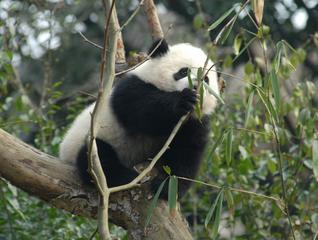Important Adaptations
Photo: Rachael Barger

The Giant Panda has many adaptations that helps it survive in the conditions that it lives in. Most of these adaptations are because of the Bamboo that the Panda eats to survive. Nutrition
The most obvious adaptation to help it eat many different types of Bamboo is its 'sixth toe'. The Giant Panda has five regular appendages that humans would consider toes or fingers. It also has a sixth 'thumb' that allows the Giant Panda to grasp Bamboo better for eating. It also helps the Panda pull the shoots and leaves off of Bamboo stems. The Pandas 'thumb' is actually an extension of the wrist bone. It is a very important adaptation for the Panda to be able to eat so much Bamboo.
The Giant Panda Bears head is also an adaptation to eating Bamboo. Giant Pandas are in the family Ursidae, which is the bear family. The Giant Panda has a very large head compared to the other species in its family. The head is so large because Bamboo is a very strong, hard plant. The Panda needs very strong jaw muscles to chew the Bamboo therefore the head has gotten larger to accommodate the larger jaw muscles. If the jaw muscles were not this strong, the Giant Panda would die off because Bamboo is its main source of food.
Another adaptation having to do with the Giant
Pandas head is its molars. The molars of the Giant Panda have adapted to
being very large and smooth. This makes the Giant Panda different from
most bears because it only uses its molars to chew the very tough Bamboo.
The molars are usually not very important in the Ursidae family because they use
their canines to eat and kill food. Giant Pandas rarely use their canine
teeth for anything. Photo: David Blank
Photo: David Blank
The Giant Panda has a specialized digestive system for eating Bamboo as well. Bamboo is a very hard, tough plant and therefore doesn't go down as smoothly as say, meat. The Giant Pandas esophagus has developed a very strong lining so that when Bamboo goes down it, it won't rip or tear. The same goes for the stomach. The stomach of Giant Pandas is very strong and muscular. Bamboo isn't easy to digest, so the stomach has to be stronger than the normal bear stomach to avoid any unwanted problems with digestion. The intestine of the Panda is short compared to other bears. It is short because the Bamboo has a lot of cellulose in it, and goes straight through the body. Because the intestines are so short, the colon is much larger than other bears colons. The Giant Panda only drinks about once a day, so it does not produce waste as frequently as other bears. Cellulose is also the majority of Bamboo, so it passes straight through the body. The colon needs to be bigger also because of how much the Panda is putting into its body compared to how much it gets rid of wastes.
The Giant Panda moves on all four legs. It has no heel pad for its feet which is why when you see them walk, they seem like they are flat-footed. Their legs are very strong and muscular because they are always moving, even though they don't move very far. They can run, but they generally move at a slower pace.